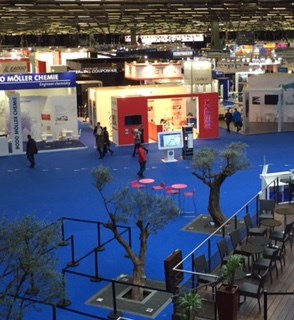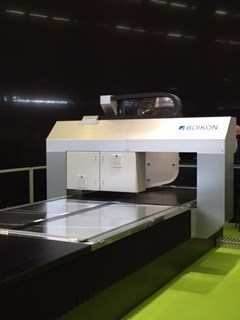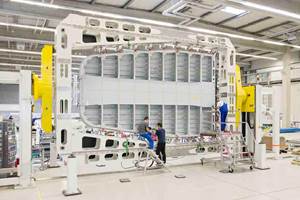2016 JEC World in Paris (Day 2): Composites in transition
The JEC Europe show has evolved over the past two decades into a very large and very busy convention, with a grown-up feel.

Live olive trees grow inside the 2016 JEC World venue.
It’s a long way from the CNIT La Defense, to Porte de Versailles convention center, to the Paris Nord Parc des Expositions near Charles de Gaulle airport, in both distance and scale. The JEC Europe show has evolved over the past two decades into a very large and very busy convention, with a grown-up feel. “The big trend in composites is industrialization — we’re transitioning from a cottage industry to large-scale production,” said Carmelo Lo Faro in an interview with CW. Lo Faro is executive vice president at Solvay (having spent his career at Cytec) and is responsible for strategy and business development for Solvay’s Composites Materials business. He added “There’s a clear and compelling need being expressed by our customers for lightweight solutions, everywhere in the world.” That light-weighting push has spurred development in materials and process, evident at every stand, for aerospace, industrial apps, and particularly, in automotive. Car parts, cars, and even city buses were parked on the show floor to demonstrate new mobility applications.

The winner of a JEC Innovation award in the category of urban transportation: an all-composite bus body in use in Budapest, Hungary
Amid the usual intensive meetings, huddles and visitor traffic, several announcements stood out. Continental Structural Plastics (CSP, Auburn Hills, MI, US) and Mitsubishi Rayon Co. Ltd. (MRC, Tokyo, Japan) say they have established a memorandum of understanding regarding the development and manufacturing of innovative carbon fiber structural components for the automotive industry in North America. Under the MOU, CSP and MRC have agreed to commence detailed studies to investigate compression molded components made from carbon fiber reinforced plastic materials, which could include carbon fiber sheet molded compound (SMC) and prepreg carbon fiber compression molding (PCM). These components will include Class A body panels, as well as non-class A structural automotive applications.

Boikon's automated thermoplastic layup machine with continuous ultrasonic tacking capability.
The growth of thermoplastics is evident, from all-thermoplastic, bonded primary wing structure for aerospace, to sophisticated processing for thermoplastic parts that replace thermoset designs. As one process supplier told me, “Thermoplastic is the only way to go.” And for both TPs and thermosets, automation is exploding. The Stellar Project, a consortium led by UK’s NetComposites (Chesterfield, UK) that includes Fraunhofer IPT and others, is aimed at developing rapid, automated thermoplastic tape layup. NetComposites showed the fruits of the group’s progress with prototype parts and a demonstration of the tape laying concept. On display in the Demo area was an automated machine by Boikon (Leek, The Netherlands) that the company says is the world’s first automated layup system based on continuous ultrasonic tacking technology. The “Falko” head lays unidirectional thermoplastic tapes that are tacked to one another in a safe and consistent process that allows near-net shape laminates to be easily handled prior to consolidation.
Pinette Emidecau Industries (Chalon Sur Saone, France) announced the successful completion of a complete turnkey plant in Vietnam for a Canadian customer that includes nearly 100 machines (metal milling, forming presses, and more, for the entire product process) to make industrial tires and rollers with little operator input. And Mikrosam (Prilep, Macedonia) revealed it is working on its most sophisticated filament winding line yet, an almost fully-automated production facility capable of making any type of compressed natural gas (CNG) tank at high rate with very little human interaction.
And materials of all types, optimized with fast serial production in mind, are on display. As one example, 3B Binani (Battice, Belgium) offered a new pelletized and agglomerated chopped glass product for polyamides that eliminates “fuzz and fly” and reportedly enables faster processing with better part quality.
There will be a lot more to follow from CW about the show. As Lo Faro summed up, “I feel extremely lucky to be working in this industry. We’re entering a phase of tremendous growth and innovation."
Related Content
From the CW Archives: Airbus A400M cargo door
The inaugural CW From the Archives revisits Sara Black’s 2007 story on out-of-autoclave infusion used to fabricate the massive composite upper cargo door for the Airbus A400M military airlifter.
Read MoreFlyber launches U.K. composites manufacturing site for advanced mobility applications
The startup’s design automation and composite material layup and curing technologies target lightweighting for aerospace, UAVs, eVTOL and high-performance mobility platforms.
Read MoreSyensqo, Teijin Carbon achieve aerospace qualification for composite resin
Resin infusion system Prism EP2400 achieves NCAMP qualification with Teijin Carbon’s advanced NCF and UD reinforcements.
Read MorePrepreg compression molding supports higher-rate propeller manufacturing
To meet increasing UAV market demands, Mejzlik Propellers has added a higher-rate compression molding line to its custom CFRP propeller capabilities.
Read MoreRead Next
Next-gen fan blades: Hybrid twin RTM, printed sensors, laser shock disassembly
MORPHO project demonstrates blade with 20% faster RTM cure cycle, uses AI-based monitoring for improved maintenance/life cycle management and proves laser shock disassembly for recycling.
Read MoreCeramic matrix composites: Faster, cheaper, higher temperature
New players proliferate, increasing CMC materials and manufacturing capacity, novel processes and automation to meet demand for higher part volumes and performance.
Read MoreScaling up, optimizing the flax fiber composite camper
Greenlander’s Sherpa RV cab, which is largely constructed from flax fiber/bio-epoxy sandwich panels, nears commercial production readiness and next-generation scale-up.
Read More












